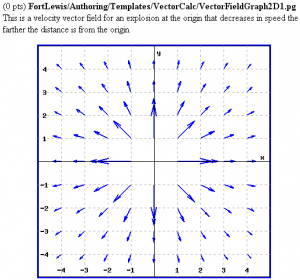VectorFieldGraph2D1
Graphing a Vector Field in the Plane
This PG code shows how to graph a vector field in the plane.
- Download file: File:VectorFieldGraph2D1.txt (change the file extension from txt to pg when you save it)
- File location in NPL:
FortLewis/Authoring/Templates/VectorCalc/VectorFieldGraph2D1.pg
| PG problem file | Explanation |
|---|---|
|
Problem tagging: |
|
DOCUMENT(); loadMacros( "PGstandard.pl", "MathObjects.pl", "PGgraphmacros.pl", "VectorField2D.pl", ); TEXT(beginproblem()); $refreshCachedImages = 1; |
Initialization:
We need to include the macros file |
Context()->variables->add(y=>"Real");
#
# Create a graph canvas
#
$gr = init_graph(-5,-5,5,5,grid=>[10,10],axes=>[0,0],pixels=>[400,400]);
$gr->lb('reset');
foreach my $j (1..4) {
$gr->lb( new Label(-4.7, $j, $j,'black','center','middle'));
$gr->lb( new Label(-4.7, -$j,-$j,'black','center','middle'));
$gr->lb( new Label( $j,-4.7, $j,'black','center','middle'));
$gr->lb( new Label( -$j,-4.7,-$j,'black','center','middle'));
}
$gr->lb( new Label(4.7,0.2,'x','black','center','middle'));
$gr->lb( new Label(0.2,4.7,'y','black','center','middle'));
VectorField2D(
graphobject => $gr,
Fx => Formula("x/(x^2+y^2)"),
Fy => Formula("y/(x^2+y^2)"),
xvar => "x",
yvar => "y",
xmin => -5,
xmax => 5,
ymin => -5,
ymax => 5,
xsamples => 10,
ysamples => 10,
vectorcolor => "blue",
vectorscale => 1.5,
vectorthickness => 2,
xavoid=>0,
yavoid=>0,
);
|
Setup:
We create a blank graph canvas and add labels to it. Then, using the |
Context()->texStrings;
BEGIN_TEXT
This is a velocity vector field for an explosion at the origin
that decreases in speed the farther the distance is from the origin.
$PAR
$BCENTER
\{ image(insertGraph($gr),width=>400,height=>400,tex_size=>700) \}
$ECENTER
END_TEXT
Context()->normalStrings;
|
Main Text: |
$showPartialCorrectAnswers = 1; |
Answer Evaluation: |
Context()->texStrings;
BEGIN_SOLUTION
${PAR}SOLUTION:${PAR}
Solution explanation goes here.
END_SOLUTION
Context()->normalStrings;
COMMENT('MathObject version.');
ENDDOCUMENT();
|
Solution: |
